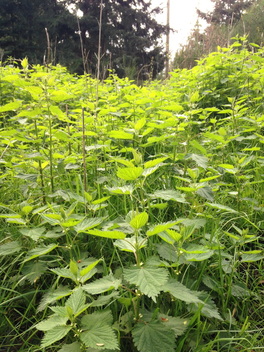 What Are They? Stinging nettles are a spring time plant that pops up in ditches, and areas with moist, nutritious soil. They are covered in tiny bristles that are actually hollow needles which sting when touched. Most people consider them a weed but nettles are actually a wonderfully healing herb with amazing properties. What Can They Do? Nettles are high in minerals. They contain Vitamin K for clotting, Iron for anemia, Silica for healing skin, Beta Carotene for eye health, Vitamins A + B for immune health and metabolization as well as Chlorophyll . Nettles are great for post pregnancy to stop bleeding and to fortify the blood with iron to prevent anemia. They are a great way to get minerals into the body including boron which helps to retain calcium for stronger bones. Nettles reduce pain and increase the efficacy of NSAIDs like aspirin and IBuprophen. Juice of the leaves acts as a diuretic which is helpful for people with BPH (benign prostate hypertrophy) as well as high blood pressure (Hypertension). The juice will also get rid of warts and regenerate hair when applied topically. Nettles have been shown to reduce cancer in patients with prostate cancer. It is an antioxidant which is great for people with heart issues. Nettle supplementation in combination with Saw Palmetto is as effective as taking the pharmaceutical Fenasteride for BPH. Lowering blood sugar is important for people with Diabetes and nettles act to improve the body's glycemic control. 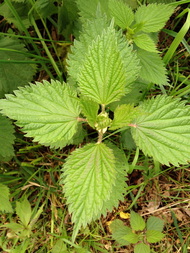 What Else Do They Treat? Nettles are used to treat all sorts of conditions: Benign prostate hypertrophy, High Blood Pressure, Pain, Anemia, Arthritis, Bursitis, Rheumatism, Hay Fever, Seasonal Allergies, Asthma, Nose Bleeds, Cancer, Gout, Tendonitis, Fibroids, Dysmenorrhea and Diabetes. Wow... What a list! If you suffer from Seasonal Allergies, nettles are a great way to end the congestion, runny nose and itchy eyes. Nettle tea has been shown to relieve seasonal allergies: 2-3 cups per day. 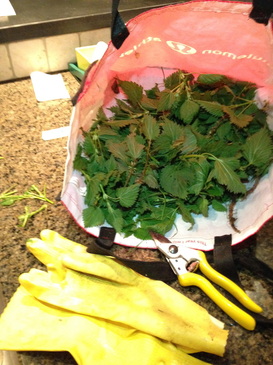 How Can I Harvest Them? Nettles grow all over in the spring. They like damp soil along ditches but can grow in large patches that get sun. Look in the woods, or an area with a stream. They have a serrated leaf, that looks a bit like a mint plant with bigger leaves. The stems have a "fur" on them which is the stinging part, so be careful! To harvest, use only the small young plants, or cut the top 2-6 leaves off of the larger ones. Put them in a bag and bring them home. How Do I Use Them? Nettle Tea: add fresh or dried nettles to a cup and add boiling water to the top. Steep covered for 5 minutes. You can mix nettles with other herbs like mint or even roiboos to create a flavor that you love! Fresh Nettle Juice: if you have a juicer you can make nettle juice. Combine them with other green juice vegetables like: cabbage, romaine, watercress, celery and green apple for a delicious and mineral rich infusion. Dried: Nettles can be dried in a dehydrator or by placing them in a paper bag and sticking them somewhere warm, like the furnace room. After they are dried they can be stored in glass containers and used as tea or added to food as you would any other herb. In Soup: I love to add nettles to soup and then blend it up with a hand blender. In this recipe I added nettles to hippocrates soup with some homemade saurkraut and the outcome was delicious. Enjoy springtime by getting out and gathering some nettles. They are a beautiful and loving plant that has a lot to offer us healthwise when we are open and receptive to their gifts. Enjoy!
Aloha xo
1 Comment
Skin Deep...Your skin is the largest organ in your body. Anything that we put on our skin is absorbed directly into the body. Think about that... How many products do you put on, or in your body each day. Here is a list of possible options: Tooth paste Mouthwash Soap Shower gel Shaving cream Moisturizer Shampoo/Conditioner Hair Styling products Deodorant Sun screen Makeup (eye liner, mascara, blush/bronzer, foundation, eye shadow, cover up) Lip balm/Lip stick/gloss Here is a list of chemicals you may come into contact with each day: Dish soap Laundry soap Bathroom cleaner Kitchen cleaner Water contaminants Pesticides Pollution A company called Bionsen did some research and found that the average woman puts about 515 synthetic chemicals on her skin each day. Have a look: Its the job of the liver to detoxify our system. In today's world with all the chemicals we encounter in body products, food and the environment, that is quite a burden. When our liver's detoxification system gets backed up, either from too many toxins going in, or not enough substrates to supply the detox reactions, we can feel it: fatigue, nausea, headaches, skin irritation, body pain, abdominal tenderness, pungent sweat to name a few. An over burdened system can also look like hormone imbalances, since it is the liver that processes and removes old and excess hormones from our bodies: weight gain, acne, painful periods, fibroids and PMS. What can I do to decrease my toxin load1. Eat Organic! Eating organic eliminates all the pesticide toxicity that one would encounter from food. For more information on pesticides check out my article on Glyphosate here. An easy way to start eating organic is to have a look at The Dirty Dozen list. These are the foods that are sprayed most and which should be avoided. There is also a Clean 15, the foods you can buy conventionally which will have a lower pesticide incidence. 2. Use Natural Household Cleaners Products with orange essential oil and vinegar are examples of natural house hold cleaners. They don't use harsh detergents or chemicals to get rid of bacteria but they work just as well. We like to use Frog Wash for our household cleaning needs. 3. Use or Make Your Own Natural Body Products For the last few months I have been using a deodorant that I made myself with a simple recipe. It works REALLY WELL! I have used it in both tropical and North American climates and it stands the test. Best of all it smells great. Regular antiperspirants have aluminum in them, which has been linked to the development of early aging in the brain and neurodegenerative diseases like Alzheimer's and dementia. Deodorant recipe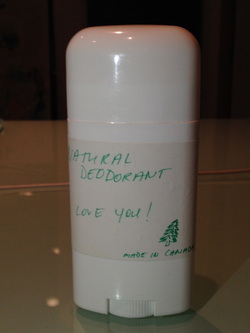 Ingredients 2 tbs coconut oil 2 tbs baking soda 2 tbs cornstarch 5-8 drops Essential oil (Rosemary, Tea Tree, Lavender, Sage, its up to you!) - In a saucepan on low, heat the coconut oil up just until it melts. Add in the other ingredients and stir. Pour into a small glass container or an old deodorant container and voilà. If you are using an old deodorant container, keep it in the fridge. It is easier to put on when it is solid. - Remember: to dip your fingers in when they are clean, and do not double dip. There is no preservative in your natural product so you don't want to contaminate it with bacteria. To learn more about having radiantly healthy skin, natural body products and detox send me a message or book an appointment today!
|
Archives
May 2019
Categories
All
|
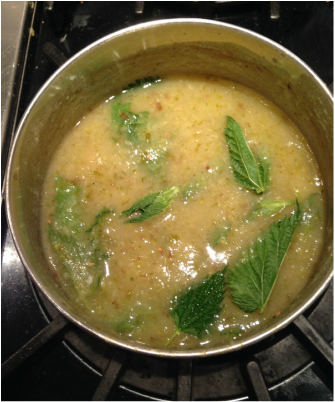
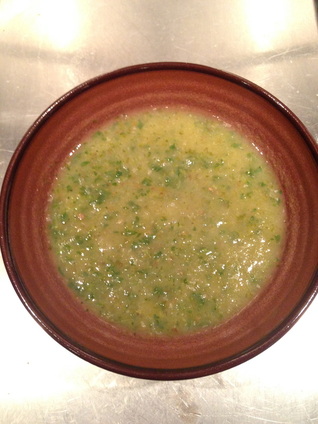

 RSS Feed
RSS Feed